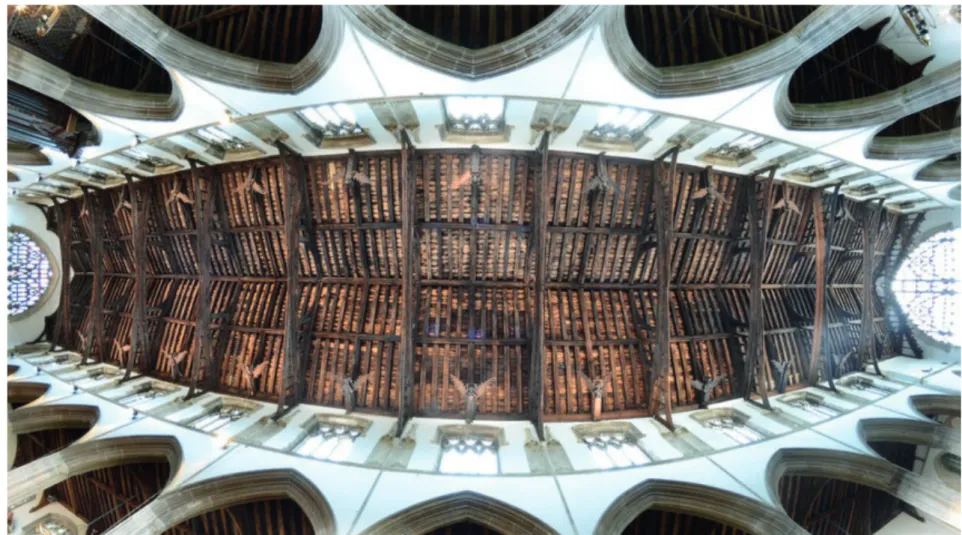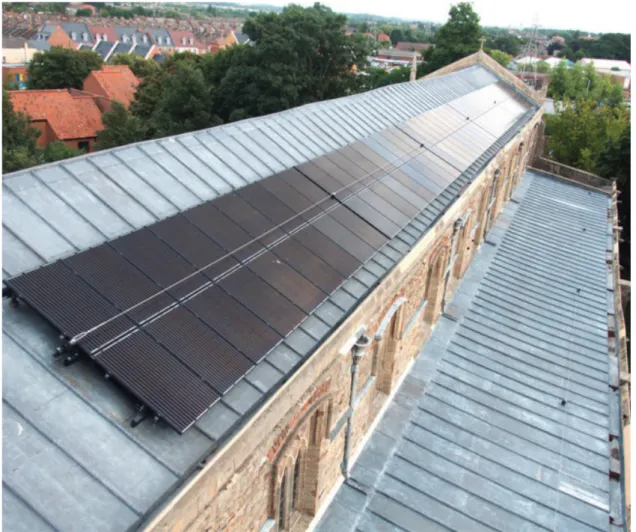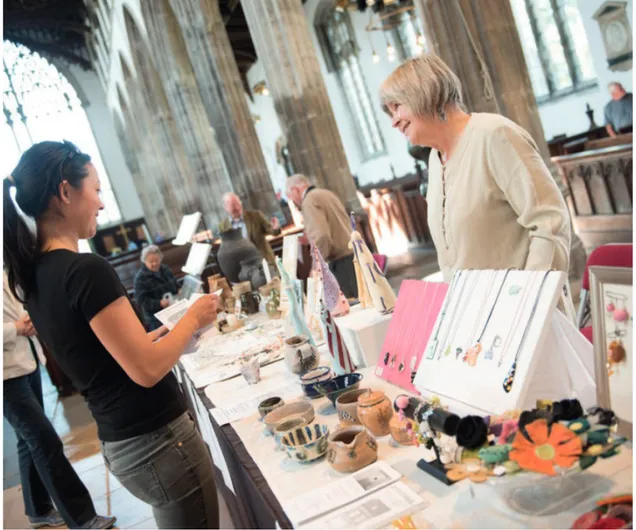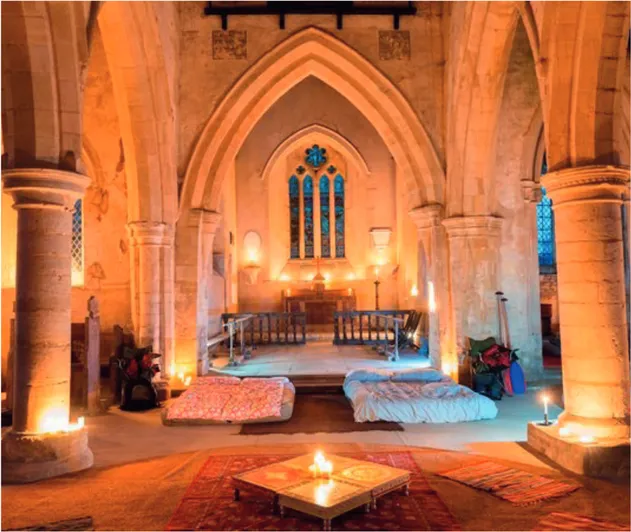Ispirato dal passato – Coinvolto nel presente – Garante del futuro
Inspired by the Past – Engaging the Present – Securing the Future
Matthew Mckeague
Director of Regeneration for The Churches Conservation Trust and the Project Director for the Trust’s major regeneration projects. Matthew has over fifteen years’ experience working in the public, private and third sectors and has been working in the historic building sector for the past eight. As well as experience of developing new uses for historic buildings he has many years’ experience of developing new community enterprise projects. He has led the Trust’s Regeneration Taskforce for the past 4 years and has developed training and capacity building programmes to facilitate learning from the Trust’s experience.
Keywords: Regeneration; Reuse; Churches; Community; Enterprise
This is a challenging time for historic churches, but one with many new opportunities. Once-secure funding streams are drying up, and there is little prospect of them ever coming back. For religious heritage organisations this is particularly problematic, as the move to a secular society has meant younger generations simply do not have the same connection to church buildings as their parents and grandparents. There is a real danger that our rich religious heritage, and with it the histories of local communities nationwide, may be completely forgotten about, and lost forever.
Yet churches have adapted to changing times throughout history. Pre-reformation they were the first community centres; meeting places and marketplaces. They successfully adapted first to Puritan stern, silent places exclusively for worship, then to the more relaxed religious culture of Anglicanism. They can adapt to a changing society today. This paper looks at the work of the Churches Conservation Trust in developing new and extended uses for its collection of historic churches.
Questo è un momento difficile per le chiese storiche, ma con molte nuove opportunità. Finanziamenti un tempo sicuri che si stanno prosciugando, e vi sono scarse prospettive di un loro reincremento. Per le organizzazioni che si occupano di patrimonio religioso, ciò è particolarmente problematico, in quanto, il passaggio a una società laica ha significato generazioni più giovani che semplicemente non hanno lo stesso legame con le chiese come i loro genitori e i loro nonni. C’è un reale pericolo che il nostro ricco patrimonio religioso, e con esso, le storie delle comunità locali, a livello nazionale, possa essere completamente dimenticato e perso per sempre. Eppure le chiese si sono adattate ai tempi che cambiano, nel corso della storia. Ante-riforma esse sono state i primi centri sociali; luoghi di incontro e mercati. Si sono adattate con successo per prima cosa al severo puritanesimo, luoghi silenziosi esclusivamente per il culto, quindi alla cultura religiosa più accomodante dell’Anglicanesimo. Esse possono adattarsi ad una società oggi in cambiamento. Questo documento esamina il lavoro delle Chiese del Conservation Trust nello sviluppo di nuovi ed estesi usi per il suo patrimonio di chiese storiche.
Parole chiave: Rigenerazione; Riutilizzo; Chiese; Comunità; Impresa
134 Introduction
The Churches Conservation Trust (CCT) cares for the third largest historic estate in charitable ownership in the UK, a unique and ever-growing collection of nearly 350 Grade I or II* historic churches. The collection is diverse, ranging from considerable town-centre churches such as St Mary’s in Shrewsbury (Fig. 1) and St Thomas’s in Bristol through to more modest, undiscovered rural gems like St Mary’s, Hardington Bampfyle, Somerset and St Thomas’s, East Shefford, Berkshire
The CCT was set up in the 1960s with a very specific remit: to preserve and conserve redundant Anglican churches with particular cultural, historical or architectural merit. Each of our churches is therefore remarkable in its own right. Our estate encompasses Saxon towers, Georgian follies, and Perpendicular masterpieces; the earliest churches in cities of the Industrial Revolution, semi-ruins where only the tower still stands, and even a unique Puritan chapel completely unaltered (and almost entirely unused) since its construction in 1660. We look after churches from Cornwall’s Roseland Coast to the foothills of the Northumberland Cheviots, but by far the greatest concentration of our estate is in East Anglia. We have 28 churches across Norfolk – more than in any other county – demonstrating the county’s rich ecclesiastical
135
three in Norwich itself: St Laurence’s, St John Maddermarket, and St Augustine’s, which boasts Norwich’s only 17th-century brick tower.
Core funding for the care of these churches comes from the Department for Culture Media and Sport and the Church of England, but these sources of income are declining in real terms, while our estate grows ever larger. We faced cuts in funding of 20% over the last Parliament and the current economic turmoil means we cannot assume anything with certainty in terms of future funding.
We are meeting this challenge by stepping up our drive to raise funds through donations, commercial income and through innovative partnerships. We’ve been making strides in all these areas over the past few years: visitor numbers at our churches have risen and are now just shy of two million annually, and visitor donations have followed suit. But this still only accounts for a small proportion of our total financial needs, and we need to go above and beyond if we are to continue to achieve our aims to keep churches safe, welcoming to visitors and a focus for community life.
Securing the future; learning from the past
Key to achieving this is the re-use or ‘repurposing’ of some of our historic churches. This can mean a variety of things – the simplest being increasing the number of events, services
and open days in churches that have previously been little used. At the other end of the scale are major interventions and adaptations of churches where there are possibilities to work in partnerships with stakeholders, commercial businesses, local government, charities and a range of heritage organisations and trusts to regenerate the building, and to support the wider regeneration of the surrounding community. Whilst the Trust’s primary concern is and will always be the conservation and maintenance of our churches to the highest standards, we are also committed to enabling community groups in both urban and rural areas to use the buildings more regularly and for a wide variety of uses. This regeneration through practical projects helps to ensure the survival of the churches for future generations to enjoy.
Church buildings are usually at the physical centre of communities, but traditionally they were the societal centre too. The mediaeval church administered much of the modern state’s remit – welfare, healthcare, education. Churches hosted the first vernacular theatre in Western Europe (mediaeval Easter Plays), and were a hub not only of community but also of commerce – the first altar screens were erected to keep animals from wandering onto the sacred area.
Provision of such amenities gradually became the domain of the state, and as schools,
hospitals and community centres opened, the community aspect of the church building declined. But in recent decades there has been a growing trend to look at how churches can begin again to provide spaces for a greater variety of uses, helping to ensure they not only survive but thrive in the 21st century. Our
approach is to work with people to identify what their community’s needs are, and to deliver projects that will meet these needs in what is likely to be their original community space.
First steps – Circomedia Bristol
The CCT trialled this approach at St Paul’s, Bristol, a late 18th century gothic revival church
with a wedding-cake tower set in a bosky Georgian square. Its surroundings had become increasingly rundown, cut off from the city centre by a 1960s distributor road system. The Grade I listed church was vested with the Trust in 2000, by which time it was derelict and almost lost to the people of Bristol (Fig.2). Vandalised, stripped of many of its features and subject to anti-social behaviour, the future looked bleak: there were gaping holes in the roof, boarded windows, and a tower on the verge of collapse.
The task of repair was a big one, and unlike many of our rural churches there were few local people who still cared enough about the church to engage in large-scale fundraising. We needed a partner. Happenchance a nearby
136
circus school, Circomedia, was looking to expand its operations and open a centre for aerial skills such as trapeze. It turned out our Georgian church, with its high, square ceiling, was eminently suitable for such a use.
A partnership was formed and four years after vesting, with an HLF grant of £2.4m towards a total project cost of £3.5m, the church had not only been conserved but transformed. A sprung floor was carefully laid over the original, and the UK’s largest indoor trapeze rig was hung from a rebuilt, strengthened roof (Fig. 3).
12 years on, Circomedia continues to go from strength to strength, and is introducing a new Master qualification in circus direction in September 2016. But its impact on the wider community is even more impressive. From the start, Circomedia has hosted community arts activity and outreach, alongside regular cultural events. This has kickstarted the regeneration of the wider area: Georgian terraces are being renovated for reoccupation; the streets are buzzing; and a neighbourhood once known for riots is fast becoming fashionable.
Going for gold – All Souls Bolton
We’re hopeful that a similar transformation will be the long-term impact of our second major regeneration project, in the North West. All Souls Bolton was a £5m project that gave a new beginning for this important late 19th-century church designed by architects
137
Fig.2 Not just circuses - music performance at Circomedia
Paley and Austin (Fig. 4). The enormous church was built for a large congregation in this densely-built district of Bolton, but over the second half of the 20th century the area
underwent demographic change and became a largely British Muslim neighbourhood. The congregation simply faded away, and the church, although structurally sound, was rarely visited and faced an enormous repair bill. In 2007, local resident Inayat Omarji recognised the church’s potential, particularly given the severe lack of community and business spaces in the surrounding area. He gathered support for the regeneration of All Souls and began to seek financial backing. In partnership with the CCT a rescue plan was developed which would breathe new life into All Souls, for the benefit of the whole local community: All Souls for all souls.
The sheer size of the nave, uninterrupted by columns, meant we could be ambitious: two modernist ‘pods’ have been inserted into the building, hosting workspaces, meeting rooms, and a coffee shop (Fig. 5). The main body of the church has been adapted to host large-scale events.
The architectural adaptions went through a rigorous consultation process that ensured the changes were appropriate and in keeping with the architectural environment of the church; while the adaption is dramatic, the intervention retains the ambiance of the building including most of the fixtures, fittings
138
and sight-lines. And like all our projects, the intervention was carefully designed to be reversible.
A key part of the project was to create a heritage wall with the local community which tells the story of the church, and of the surrounding area. We also supported local employment throughout the project. We offered six bursaries in heritage conservation throughout the project, and hosted craft skills workshops throughout the construction phase. Three of the six bursaries went onto long term employment with the conservation building contractor.
All Souls Bolton launched in August 2014, and initial results have been positive. A wide range of community activities and events are hosted in the centre. The community-run charity itself continues the skills focus by offering placements and training for underskilled young people in the surrounding area. The project has won several awards, including Civic Voice’s prize for best restoration project involving the community, and an English Heritage ‘Angel Award’ for the quality of the conservation work.
Building a sustainable future – St Nicholas’ Chapel, King’s Lynn
Back in East Anglia we have delivered a project in King’s Lynn, where the largest chapel of ease in the country has been conserved and transformed into an events space and visitor
Fig.4 The imposing exterior of Bolton All Souls
destination. This has been a partnership project with the Friends of St Nicholas Chapel, a voluntary group the likes of which are very important to our efforts in sustaining our churches and estate.
St Nicholas Chapel was built by the merchants of mediaeval King’s Lynn as a demonstration of their wealth. Dating almost entirely from the late 14th century, it is a glorious light-filled
exemplar of Perpendicular, bound at each end by two enormous, delicate windows that let light pour into the nave under the longest of East Anglia’s remarkable angel rooves (Fig. 6). The chapel later became known for its special link to the fishing community, the so-called ‘North Enders’ of King’s Lynn, but as the fishing industry wound down, the chapel’s traditional congregation moved away, and the building was eventually vested with the CCT. By the mid 2000s, rising damp and a poorly-maintained roof had left the building in a sorry state, and its lack of facilities meant it was not being used to its full potential.
The building’s magnificent unspoilt architecture meant a dramatic adaptation was never on the cards here, but we managed to squeeze toilets and a small kitchen into the base of its tower. The enormous space is heated from bespoke chandeliers that combine lights with radiant heat panels, far cheaper and less intrusive than traditional radiators or underfloor heating (figure 16). But what makes the project stand out is its sustainability
139
Fig. 5 All Souls Bolton interior, after regeneration
focus. Solar panels, invisible from street level, run the length of the roof (Fig. 7), while water is recycled from rain.
The transformed St Nicholas chapel opened in September 2015, and has seen a surge in visitor numbers well in excess of expectations, along with a growing number of activities and events (Fig. 8) – December is already being booked up for Christmas parties.
Proving the link between heritage and wellbeing – Quay Place, Ipswich
Our next major project opened in autumn 2016. Another partnership project, this time with the charity Suffolk Mind, Quay Place transforms Ipswich’s beautiful St-Mary-at-the-Quay church into a wellbeing centre, bringing an innovative new use to a church that has suffered over the past 50 years through poor town planning. It was marooned amidst dual carriageways and abandoned riverside industrial buildings, its traditional congregation wholly vanished. Yet recent regeneration in the quayside area has breathed new life into the surroundings, with new businesses, housing, and the celebrated DanceEast moving in. The start of quayside regeneration coincided with the realisation that the building was fast becoming structurally unsound: the combination of the salty air and rising damp within the building, exacerbated by impermeable concrete pumped under the floor in 20th century repair work, meant
columns in the church were rapidly crumbling, and the south side had developed a Pisan lean. We reached out to the local community to identify a project that could attract funding to save the church, but also put it on a sound financial footing for the future.
Our search for a partner led us to Suffolk Mind who were looking for a unique building to develop a wellbeing centre. Over several years we worked out the shape of the final project, in close collaboration with the local community. One-to-one wellbeing therapies will be offered in a number of consulting rooms housed in a new extension designed in a sympathetic style. The original building will host group classes, a coffee shop, and events, along with subtly-inserted business and office space. In addition, a wellbeing garden, to be maintained by volunteers, will be created on the south side of the church.
By extending as well as adapting the building, the large nave – with its wonderful double-hammerbeam roof (the oldest in Suffolk) – is largely unchanged. A sensitive modern mezzanine floor in the south aisle and gallery at the west end are the only insertions to the mediaeval structure, the mezzanine floor construction doubling up as support for the church’s leaning pillars (Fig. 9).
Quay Place is an ambitious, unique project, and it builds on an increasing body of evidence that suggests there is a link between wellbeing and connections to heritage. We will be
140
141
comparing outcomes of treatments at Quay Place with those at traditional centres for wellbeing services, not necessarily known for their architectural merit. Should the model prove successful, we hope to roll it out to other sites nationwide.
New ways of working with the community – The Common Room, Norwich
Further pilot projects by the Trust are planned. One that has been running in recent years took place at St Laurence’s in Norwich. St Laurence’s is a lovely, large church, with an impressive long, tall nave, and a lack of pews which make it more adaptable than many of our churches. Its location, however, on steep slopes leading down to the River Yare, means disabled access is a challenge, and it will be expensive to provide it with the services it needs to become a true community asset. Our approach is always to offer something that is missing from a local area, rather than competing with established venues, and thus we were very conscious of the remarkable work the Norwich Historic Churches Trust has done to find new uses for its churches in the area. We knew we had to test something different.
In St Laurence’s we ran The Common Room, a joint project with Civic Systems Lab and the University of East Anglia to test a new type of shared space, made and shaped collectively, and run on the principles of collaboration,
142
connection and resourcefulness. Part of the EU-funded Heritage Recycle project, The Common Room supported local volunteer ‘members’ to host enterprising community projects, such as Trade School Norwich, an open learning space that runs on barter, Common Soup, which combines communal meals with crowdfunding for good causes, and crafting workshops. All sessions were delivered by volunteers.
The Common Room project has continued, on a less frequent basis, beyond the end of the EU funding, and has spread to other venues throughout the city. It has also raised the profile of St Laurence’s, leading to more commercial hire such as for themed cinema evenings. We are continuing to evaluate the outcomes of the project, and hope to develop a long term and sustainable plan for the church in the future.
Inspiring the future – our heritage learning programme
We carefully design our regeneration projects to complement the building’s architecture and history, but many of our sites are simply too sensitive for any significant intervention. We have therefore developed other means to bring people into these buildings, in particular through our heritage learning programme, where local schools visit our churches to discover more about their history and to take part in interactive workshops.
143
We consider each church’s specific features and links to town history to develop bespoke programmes; for example, workshops in King’s Lynn focus on the town’s history as a Hanseatic League trading hub.
In Norwich we’ve found that St John’s Maddermarket lends itself to heritage conservation workshops. This treasure-trove church has an outstanding collection of intricately-sculpted memorials, mediaeval brass work, and image-rich stained glass. Activities here have included workshops on stained glass, tile or wall-painting conservation, where schoolchildren discover how to carefully clean historic objects (replicas of course!) and repair and retouch where necessary, workshops on how to ‘read’ a church (architectural features, materials, monuments), as well as sessions focussing on the church’s strong links to Lord Mayors of Bristol. We have built a highly successful partnership with the Norwich Free School, and 723 schoolchildren have taken part in activities linked to St John’s Maddermarket. We are always on the look out for new partnerships at all our churches.
New uses by night – Champing™
Champing™ – church camping – is our latest initiative to get a wider audience appreciating our churches. Inspired by ‘glamping’, the concept is simple: we provide camper
beds, electric candles, and basic loos; you Fig. 9 The new mezzanine provides structural support as well as meeting space
144
bring bedding, a torch, and respect for the surroundings but also a sense of fun. We have arrangements with local farmers and pubs to provide breakfast, and champers are guaranteed an undisturbed night with the church to themselves (Fig. 10).
Champing™ has really captured people’s attention since it launched last year. We’ve had coverage in The Telegraph, The Daily Mail,
The Guardian and in newspapers across the
Netherlands, Germany, America and even Australia. This has brought unprecedented attention to the activities of the CCT, and has attracted a more diverse demographic to our sites, particularly younger urbanites. We hope this will encourage a whole new generation to become interested in England’s historic churches – and have already seen encouraging cases of Champers becoming CCT supporters, members and volunteers.
From four pilot sites, 10 churches are open for Champing™ this year, including Norfolk’s extraordinary St Michael the Archangel church in Booton, known as the Cathedral of the Fields. This church was the brainchild of the eccentric clergyman Whitwell Elwin, who rebuilt the church in the late 19th century
after his own design, taking elements from his favourite church buildings across England (the west doors from Glastonbury Abbey, stained glass windows from Temple Balsall, Warwickshire, a typically East Anglian angel roof), from his own imagination (the twin
145
towers set 45 degrees from the church plan, the minaret-like central pinnacle), and even from his personal acquaintance. The result is a remarkably eccentric construction that could be at home in Disneyland as well as the Norfolk countryside. With its easy access to the Bure Valley Railway and to the Norfolk coast, Booton is proving one of our more popular Champing™ churches and this unique church is finally getting the appreciation it deserves. We hope to expand Champing™ to further CCT sites in future years, including in the north and west of England, but are also hoping to form partnerships with other church organisations to spread the concept further. We’ve already had interesting in franchising the concept from churches as far away as Orkney.
Our religious heritage – past, present and future
This is a still challenging time but one with many new opportunities. Once-secure funding streams are drying up, and there is little prospect of them ever coming back. For religious heritage organisations this is particularly problematic, as the move to a secular society has meant younger generations simply do not have the same connection to church buildings as their parents and grandparents. There is a real danger that our rich religious heritage, and with it the histories of local communities nationwide, may be completely forgotten about, and lost forever.
Yet churches have adapted to changing times throughout history. Pre-reformation they were the first community centres; meeting places and marketplaces. They successfully adapted first to Puritan stern, silent places exclusively for worship, then to the more relaxed religious culture of Anglicanism. They can adapt to a changing society today.
We need to make an effort. We need to find uses for buildings that are driven by local communities’ needs and demands, and involve people in the process every step of the way. We need to make churches attractive to new audiences and demographics. We need to reach out to young people who, the product of several generations of non-attendance, otherwise have no link to church buildings. This isn’t easy, but there are exciting possibilities. Churches were the first community centres; they can become centres of community again. And in doing so, we can preserve our remarkable heritage and history for future generations.




